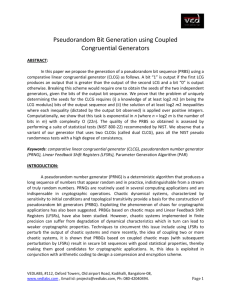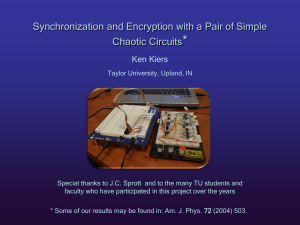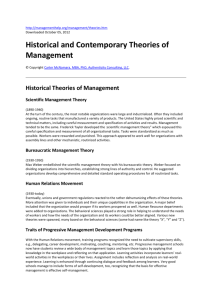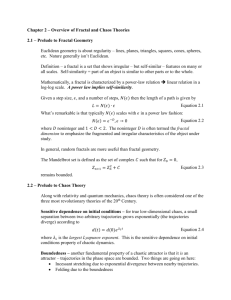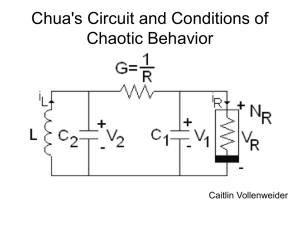Pseudo random bit generation using chaotic standard mapping
advertisement
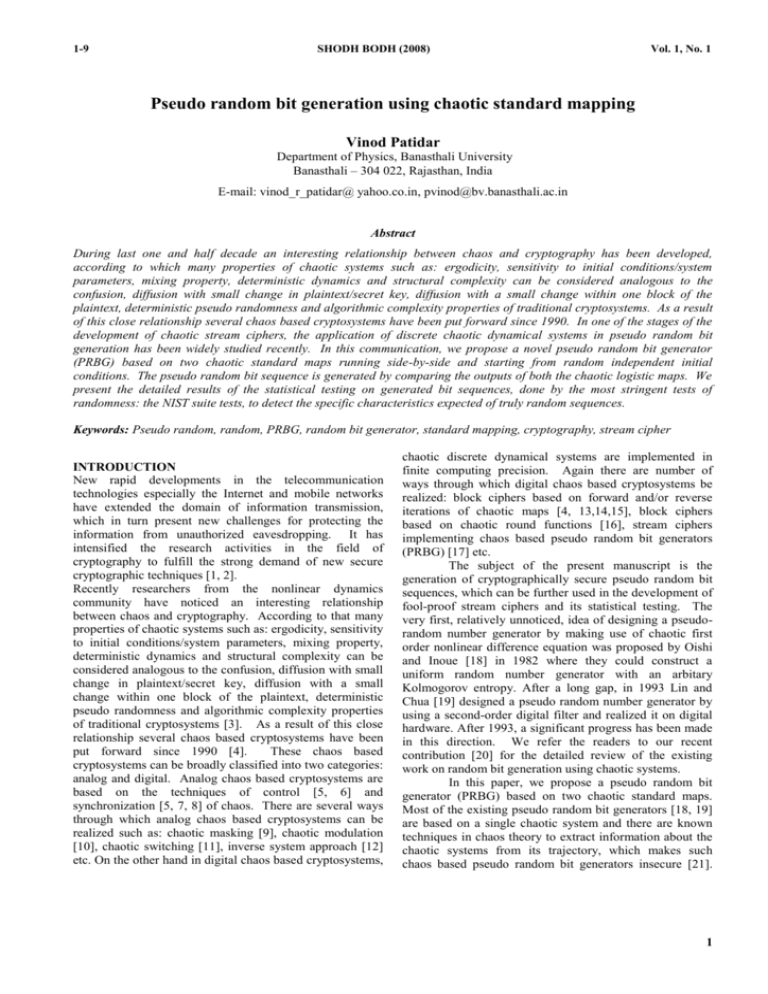
1-9 SHODH BODH (2008) Vol. 1, No. 1 Pseudo random bit generation using chaotic standard mapping Vinod Patidar Department of Physics, Banasthali University Banasthali – 304 022, Rajasthan, India E-mail: vinod_r_patidar@ yahoo.co.in, pvinod@bv.banasthali.ac.in Abstract During last one and half decade an interesting relationship between chaos and cryptography has been developed, according to which many properties of chaotic systems such as: ergodicity, sensitivity to initial conditions/system parameters, mixing property, deterministic dynamics and structural complexity can be considered analogous to the confusion, diffusion with small change in plaintext/secret key, diffusion with a small change within one block of the plaintext, deterministic pseudo randomness and algorithmic complexity properties of traditional cryptosystems. As a result of this close relationship several chaos based cryptosystems have been put forward since 1990. In one of the stages of the development of chaotic stream ciphers, the application of discrete chaotic dynamical systems in pseudo random bit generation has been widely studied recently. In this communication, we propose a novel pseudo random bit generator (PRBG) based on two chaotic standard maps running side-by-side and starting from random independent initial conditions. The pseudo random bit sequence is generated by comparing the outputs of both the chaotic logistic maps. We present the detailed results of the statistical testing on generated bit sequences, done by the most stringent tests of randomness: the NIST suite tests, to detect the specific characteristics expected of truly random sequences. Keywords: Pseudo random, random, PRBG, random bit generator, standard mapping, cryptography, stream cipher INTRODUCTION New rapid developments in the telecommunication technologies especially the Internet and mobile networks have extended the domain of information transmission, which in turn present new challenges for protecting the information from unauthorized eavesdropping. It has intensified the research activities in the field of cryptography to fulfill the strong demand of new secure cryptographic techniques [1, 2]. Recently researchers from the nonlinear dynamics community have noticed an interesting relationship between chaos and cryptography. According to that many properties of chaotic systems such as: ergodicity, sensitivity to initial conditions/system parameters, mixing property, deterministic dynamics and structural complexity can be considered analogous to the confusion, diffusion with small change in plaintext/secret key, diffusion with a small change within one block of the plaintext, deterministic pseudo randomness and algorithmic complexity properties of traditional cryptosystems [3]. As a result of this close relationship several chaos based cryptosystems have been put forward since 1990 [4]. These chaos based cryptosystems can be broadly classified into two categories: analog and digital. Analog chaos based cryptosystems are based on the techniques of control [5, 6] and synchronization [5, 7, 8] of chaos. There are several ways through which analog chaos based cryptosystems can be realized such as: chaotic masking [9], chaotic modulation [10], chaotic switching [11], inverse system approach [12] etc. On the other hand in digital chaos based cryptosystems, chaotic discrete dynamical systems are implemented in finite computing precision. Again there are number of ways through which digital chaos based cryptosystems be realized: block ciphers based on forward and/or reverse iterations of chaotic maps [4, 13,14,15], block ciphers based on chaotic round functions [16], stream ciphers implementing chaos based pseudo random bit generators (PRBG) [17] etc. The subject of the present manuscript is the generation of cryptographically secure pseudo random bit sequences, which can be further used in the development of fool-proof stream ciphers and its statistical testing. The very first, relatively unnoticed, idea of designing a pseudorandom number generator by making use of chaotic first order nonlinear difference equation was proposed by Oishi and Inoue [18] in 1982 where they could construct a uniform random number generator with an arbitary Kolmogorov entropy. After a long gap, in 1993 Lin and Chua [19] designed a pseudo random number generator by using a second-order digital filter and realized it on digital hardware. After 1993, a significant progress has been made in this direction. We refer the readers to our recent contribution [20] for the detailed review of the existing work on random bit generation using chaotic systems. In this paper, we propose a pseudo random bit generator (PRBG) based on two chaotic standard maps. Most of the existing pseudo random bit generators [18, 19] are based on a single chaotic system and there are known techniques in chaos theory to extract information about the chaotic systems from its trajectory, which makes such chaos based pseudo random bit generators insecure [21]. 1 1-9 SHODH BODH (2008) However the proposed pseudo random bit generator is based on two chaotic systems running side-by-side, which of course increases the complexity in the random bit generation and hence becomes difficult for an intruder to extract information about the chaotic system. In the next section, we briefly introduce the standard mapping, which is a basic building block of the proposed pseudo random bit generator and its properties, which make it a suitable choice for the generation of random bit sequences. THE STANDARD MAPPING The origin of the nowadays well known and widely used standard mapping lies in the field of particle physics. The problem examined by Fermi [22], as an analogue to a possible cosmic ray acceleration mechanism in which charged particles accelerated by collision with moving magnetic field structures, is that of a ball bouncing between a fixed and an oscillating wall. If every time the ball impacts, the phase of the oscillation is chosen at random, the particle will be accelerated. The question was now that, if the ball would be also accelerated, when the wall oscillation is a periodic function of time. This problem was investigated by Ulam [23] who found that the particle motion appeared to be stochastic, but did not increase its energy. Other people [24-26] demonstrated that in case of smooth forcing functions, the phase plane shows three distinct regions with increasing ball velocity: (i) a lowvelocity region where all fixed points of period -1 are unstable and thus leading to stochastic motion, (ii) an intermediate velocity region in which islands of stability around elliptic fixed points are embedded in a stochastic sea and (iii) a high velocity region in which bands of stochastic motion are separated from each other by regular orbits. As this problem of particle acceleration can be approximated by the simple mapping, it became a wellsuited case to study the parameter regions of phase space and the corresponding KAM surfaces. The exact Ulam mapping for the motion of the ball bouncing between a fixed and an oscillating wall, where the velocity is defined by a saw tooth function, is given a set of four exact difference equations. Under the area-preserving condition and if we allow the wall to add momentum to the ball according to its velocity (without a change in the position of the wall), this set of four difference equation be converted into a set of two difference equations: u n1 u n sin n , 2M n 1 n . u n 1 where u n and n respectively, are directly related to the ball velocity and phase just before the nth impact. The standard mapping is obtained by the linearization of the above set of difference equations in action space. The set of difference equations thus obtained are X n1 X n K sin Yn , Vol. 1, No. 1 Yn1 Yn X n1 , where X n is the new action parameter , which has explicit u n , Yn is the new angle obtained by shifting the phase n by and K is stochasticity dependence on parameter. The period-1 fixed point of the standard mapping can be easily obtained by requiring that the phase (mod 2 ) and the action are stationary i.e., X 1 2m ( m Z ) and Y1 0, . The fixed point Y 0 is always stable whereas the fixed point Y is stable for K 4 an changes from an elliptic fixed point to an hyperbolic fixed point with the increase in K. For the detailed derivation of the standard mapping from the original Fermi problem and its stability analysis, we refer the readers to [27]. In Figure 1, we have shown how the chaotic region in the phase space increases with K. For K 0.5 one can see the primary period-1 and period -2 orbits very clearly, only local stochasticity near the seperatrix occurs. For K 1.0 the KAM curve between the period-1 and period-2 islands has been destroyed and the chaos is global now, only the islands of stability remain. As the value of K increases the size of the islands of stability decreases. In a recent numerical experimentation [28], it has been shown that at very large values of the stochasticity parameter, there exist areas of regular motion- in fact there is a ‘creation and decay’ of the periodic orbits, which happens to repeat itself with a period of 2 . THE PROPOSED PRBG A random bit generator (RBG) is a device or algorithm, which outputs a sequence of statistically independent and unbiased binary digits. Such generator requires a naturally occurring source of randomness (non-deterministic). In most practical environments designing a hardware device or software programme to exploit the natural source of randomness and produce a bit sequence free from biases and correlation is a difficult task. In such situations, the problem can be ameliorated by replacing a random bit generator with a pseudo random bit generator (PRBG). A pseudo random bit generator (PRBG) is a deterministic algorithm, which uses a truly random binary sequence of length k as input called seed and produces a binary sequence of length l>>k, called pseudo random sequence, which appears to be random. The output of a PRBG is not truly random; in fact the number of possible output k l sequences is at most a small fraction ( 2 2 ) of all possible binary sequences of length l. The basic intent is to take a small truly random sequence of length k and expand it to a sequence of much larger length l in such a way that an adversary can not efficiently distinguish between output sequence of PRBG and truly random sequence of length l [2]. 2 1-9 SHODH BODH (2008) 0 1 2 3 4 5 Vol. 1, No. 1 0 6 1 2 3 4 5 K = 1.0 K = 0.5 6 6 6 5 5 5 5 4 4 4 4 3 3 3 3 2 2 2 2 1 1 1 1 0 0 0 0 Xn 6 0 1 2 3 Yn 4 5 6 0 1 2 3 Yn 4 5 6 0 1 2 3 4 5 6 0 1 2 3 4 5 6 K = 1.5 K = 2.5 6 5 5 5 5 4 4 4 4 3 3 2 Xn 6 Xn 6 6 3 3 2 2 2 1 1 1 1 0 0 0 0 0 1 2 3 4 Yn 5 6 0 1 2 3 4 Yn 5 6 0 1 2 3 5 6 0 1 2 3 5 6 4 K = 6.0 K = 18.9 6 6 6 5 5 5 5 4 4 4 4 Xn 6 4 Xn Xn 6 3 3 2 2 2 1 1 1 1 0 0 0 0 3 3 2 0 1 2 3 Yn 4 5 6 0 1 2 3 Yn 4 5 6 Figure 1: Phase space for the standard mapping for K = 0.5, 1.0, 1.5, 2.5, 6.0 and 18.9. 3 1-9 SHODH BODH (2008) X 1,0 Y1,0 Standard Mapping X 1,n 1 Y1,n 1 1 if X 2 ,n 1 Y2,n 1 h( X 2,n 1 , Y1,n 1 ) 0 if X 2 ,n 1 Y2,n 1 X 2 ,0 Y2 ,0 Standard Mapping Figure 2: Y2,n 1 Schematic block diagram of the proposed pseudo random bit generator (PRBG). X 1,n 1 X 1,n K sin Y1,n , Y1,n 1 Y1,n X 1,n 1 , X 2,n 1 X 2 ,n K sin Y2 ,n , Y2 ,n 1 Y2 ,n X 2 ,n 1 , The bit sequence is generated by comparing the outputs of both the standard maps in the following way: 1 if X 2 ,n 1 Y1,n 1 h( X 2 ,n 1 , Y1,n 1 ) , 0 if X 2 ,n 1 Y1,n 1 set ( X 1,0 , Y1,0 , X 2 ,0 , Y2,0 1001111000110 0…. X 2 , n 1 In this paper, we are proposing a PRBG, which is based on two standard maps, starting from random independent initial conditions ( X 1,0 , Y1,0 , X 2 ,0 , Y2,0 [0, 2 ] ) The Vol. 1, No. 1 of initial conditions [0, 2 ] ) serves as the seed for the PRBG, if we supply the exactly same seed to the PRBG, it will produce the same bit sequence due to the above deterministic procedure. The schematic block diagram of the proposed PRBG is shown in Figure 2. In the next section, we discuss the results of the statistical testing of the proposed PRBG using the NIST (National Institute of Standards and Technology, Gaithersberg, MD, USA) tests suite, which is the most stringent statistical tests suite to test randomness. STATISTICAL TESTING In order to gain the confidence that newly developed pseudo random bit generators are cryptographically secure, they should be subjected to a variety of statistical tests designed to detect the specific characteristics expected of truly random sequences. There are several options available for analyzing the randomness of the newly developed pseudo random bit generators. The four most popular options are: NIST suite of statistical tests, the DIEHARD suite of statistical tests, The Crypt-XS suite of statistical tests and the Donald Knuth’s statistical tests set. There are different number of statistical tests in each of the above mentioned test suites to detect distinct types of nonrandomness in the binary sequences. Various efforts based on the principal component analysis show that not all the above mentioned suites are needed to implement at a time as there are redundancy in the statistical tests (i.e., all the tests are not independent). The results also suggest that the NIST statistical tests suite contains a sufficient number of nearly independent statistical tests, which detect any deviation from the randomness. Hence for analyzing the randomness of the proposed pseudo random bit generator (PRBG), we use the most stringent tests of randomness: the NIST suite tests. The NIST tests suite is a statistical package comprising of 16 tests that are developed to test the randomness of (arbitrary long) binary sequences produced by either hardware or software based cryptographic random (8) or pseudo random bit generators. These tests focus on variety of different types of non-randomness that could exist in a binary sequence. Broadly, we may classify these sixteen tests into two categories: (i) non-parameterized tests and (ii) parameterized tests. For the detailed description of all 16 tests of NIST suite, we refer the readers to the NIST document [29]. Testing strategy: The NIST framework, like many statistical tests, is based on hypothesis testing. A hypothesis test is a procedure for determining if an assertion about a characteristic of a population is reasonable. In the present case, the test involves determining whether or not a specific sequence of zeroes and ones is random (it is called null hypothesis H 0 ). For each test, a relevant randomness statistic be chosen and used to determine the acceptance or rejection of the null hypothesis. Under an assumption of randomness, such a statistic has a distribution of possible values. A theoretical reference distribution of this statistic under the null hypothesis is determined by mathematical methods and corresponding probability value (P-value) is computed, which summarizes the strength of the evidence against the null hypothesis. For each test, the P-value is the probability that a perfect random number generator would have produced a sequence less random than the sequence that was tested, given the kind of non-randomness assessed by- 4 1-9 SHODH BODH (2008) Vol. 1, No. 1 Table 1: Non-parameterized tests results: Number of binary sequences tested ( m ): 100 Length of each binary sequence: 1,000,000 bits Significance level ( ) = 0.01 The range of acceptable proportion is 0.99 0.02985 Null hypothesis ( H 0 ): The binary sequence is random If P value (0.01) then the null hypothesis ( H 0 ) is accepted. If P value (0.01) then the null hypothesis ( H 0 ) is rejected. If P valueT ( P value corresponding to the Goodness-of-Fit distributional test on the P values obtained for a particular test i.e., a P value of the P values ) 0.0001 then P values can be considered uniformly distributed. S. No. 1. Frequency (monobit) test 2. Runs test 3. Test for longest run of ones in a block Lempel-Ziv compression test Binary matrix rank test Cumulative sums test 4. 5. 6. 7. 8. 9. Statistical Test 1) Forward sums test 2) Reverse sums test Discrete Fourier transform (spectral) test Random excursions test 1) x = -4 2) x = -3 3) x = -2 4) x = -1 5) x = 1 6) x = 2 7) x = 3 8) x = 4 Random excursions variant test 1) x = -9 2) x = -8 3) x = -7 4) x = -6 5) x = -5 6) x = -4 7) x = -3 8) x = -2 9) x = -1 10) x = 1 11) x = 2 12) x = 3 13) x = 4 P value corresponding to the goodness of fit ( P valueT ) 0.236810 Proportion of sequences passing the test 1.0000 Test not run 0.0000 0.9500 0.0000 0.554420 1.0000 0.9800 0.213309 0.514124 0.366918 1.0000 0.9900 1.0000 0.014550 0.334538 0.062821 0.004629 0.181557 0.437274 0.145326 0.946308 1.0000 0.9661 1.0000 1.0000 1.0000 0.9831 1.0000 1.0000 0.202268 0.304126 0.071177 0.304126 0.304126 0.334538 0.304126 0.834308 0.102526 0.249284 0.080519 0.055361 0.037566 0.9831 0.9831 0.9831 0.9831 0.9831 0.9831 0.9831 1.0000 0.9831 0.9831 0.9831 1.0000 1.0000 5 1-9 SHODH BODH (2008) Table 1 (contd.) 14) x = 5 15) x = 6 16) x = 7 17) x = 8 18) x = 9 Vol. 1, No. 1 0.019188 0.006196 0.042808 0.062821 0.304126 0.9831 0.9831 1.0000 1.0000 1.0000 Table 2: Parameterized tests results: Number of binary sequences tested ( m ): 100 Length of each binary sequence: 1,000,000 bits Significance level ( ) = 0.01 The range of acceptable proportion is 0.99 0.02985 Null hypothesis ( H 0 ): The binary sequence is random If P value (0.01) then the null hypothesis ( H 0 ) is accepted. If P value (0.01) then the null hypothesis ( H 0 ) is rejected. If P valueT ( P value corresponding to the Goodness-of-Fit distributional test on the P values obtained for a particular test i.e., a P value of the P values ) 0.0001 then P values can be considered uniformly distributed. S. No. P value Statistical Test corresponding to the goodness of fit ( P valueT ) 1. 2. 3. 4. 5. 6. 7. Frequency test within a block (Block length = 128 ) Approximate entropy test (Block length = 10 ) Linear complexity test (Block length =500) Maurer’s universal statistical test (No. of blocks = 7 , Block length = 1280 ) Serial test (Block length = 16 ) Overlapping template matching test (Template =111111111) Non-overlapping template matching test (Template length=9) 9) Template = 000000001 10) Template = 000100111 11) Template = 001010011 12) Template = 010001011 13) Template = 011101111 14) Template = 101101000 15) Template = 110100100 the test. If a P-value for a test is determined to be equal to 1, then the sequence appears to have perfect randomness. A P-value equal to zero indicates that the sequence appears to be completely non-random. A significance level ( ) be Proportion of sequences passing the test 0.0000 0.7900 0.0000 0.4200 0.058984 0.9900 0.554420 1.0000 0.574903 0.9900 0.0000 0.5200 0.319084 0.236810 0.002374 0.012650 0.334538 0.262249 0.275709 0.9900 0.9900 0.9800 0.9800 0.9900 1.0000 0.9700 chosen for the tests and if P value , then the null hypothesis is accepted i.e., the sequence appears to be random. If P value , then the null hypothesis is rejected; i.e., the sequence appears to be non-random. 6 SHODH BODH (2008) 6 each of length 10 bits and computed the P-value corresponding to each sequence for all the 16 tests of NIST Suite (in all we have computed total 47 100 = 4700 Pvalues). All the computations have been performed in the double precision floating point representation. We refer the readers to Rukhin et al [29] for the detailed mathematical procedure for calculating the P-value for each individual test of NIST suite. For the analysis of P-values obtained from various statistical tests, we have fixed the significance level at 0.01. In Tables 1 and 2 respectively, we have summarized the results obtained after implementing nonparameterized and parameterized tests of NIST suite on the binary sequences produced by the proposed pseudo random bit generator. Interpretation of results: (i) Uniform distribution of P-values: For each test, the distribution of P-values for a large number of binary sequences ( m 100 ) has been examined. The uniformity of the P-values has been examined quantitatively via an application of test and the determination of a P-value corresponding to the Goodness-of-Fit distributional test on the P-values obtained for each statistical test (i.e., a P-value of the P-values, which is denoted by P valueT ). The computation is as follows: 2 The P-value (i.e., P valueT ) is obtained from the of the by using 2 10 10 10 10 15 20 25 30 35 10 0 -1 10 -1 10 10 5 -2 10 -3 10 (a) -4 10 -5 10 -6 1 - Frequency 2 - Runs (not run) 3 - Longest runs 4 - Lempel-Ziv 5 - Rank 10 6 - Cusums (forward) 7 - Cusums (reverse) 8 - Spectral 9 to 16 - Random excursions 17 to 34 - Random excursions variant 0 5 10 15 0 2 4 6 20 Tests 8 25 30 35 10 12 14 0 10 10 -1 -2 -3 -4 10 -5 10 -6 10 10 0 -1 10 -2 10 -2 10 -3 10 -3 10 -4 10 -4 10 -5 10 -6 (b) 10 -5 10 -6 1234- 0 Block Frequency Approximate Entropy Linear Complexity Maurer's Universal 2 4 5 - Serial 7 - Overlapping Template Matching 8 to 13 - Non-overlapping Template Matching 6 8 Tests 10 horizontal line represents the threshold value of where f i is the number of P-values in the sub-interval i and m is the size of the sample, which is m 100 for the analysis. 0 0 12 14 Figure 3: P valueT (i.e, P-value of the P-values) for (a) nonparameterized tests and (b) parameterized tests of NIST suite. The 2 m f 10 i 10 2 , m i 1 10 present Vol. 1, No. 1 The computed P valueT corresponding to each statistical test has been given in Tables 1 and 2. In Figures 3(a) and (b) respectively, we have graphically depicted the computed P valueT for each non-parameterized and parameterized test along with the threshold value (0.0001). P- valuesT Typically, the significance level ( ) is chosen in the interval [ 0.001, 0.01 ]. The 0.01 indicates that one would expect 1 sequence out of 100 sequences to be rejected. A P value 0.01 would mean that the sequence would be considered to be random with a confidence of 99 %. For the numerical experimentations on the proposed pseudo random bit generator, we have generated 100 (sample size m 100 ) different binary sequences (each sequence has been generated from a randomly chosen seed ( X 1,0 , Y1,0 , X 2 ,0 , Y2 ,0 [0, 2 ] and K=150.72) P- valuesT 1-9 9 2 P valueT igamc , 2 2 P-values , where igamc( ) is the incomplete Gamma function. If P valueT 0.0001 then the P-values are considered to be uniformly distributed. P valueT . (ii) Proportions of the sequences passing the tests: We have calculated the proportion of the sequences passing a particular statistical test and compared it with the range of acceptable proportion. The range of acceptable proportion is determined by using the confidence interval given by pˆ (1 pˆ ) , m where m is the sample size and p̂ 1 , which are m 100 and pˆ 1 0.01 0.99 for the present pˆ 3 analysis. So the range of acceptable proportion is The quantitative results of proportions are given the Tables 1 and 2 respectively for [1.01985, 0.96015] . 7 1-9 SHODH BODH (2008) various non-parameterized and parameterized statistical tests of NIST suite. In Figures 4(a) and (b) respectively, we have graphically depicted the computed proportions for each non-parameterized and parameterized test along with the confidence interval i.e., [1.01985, 0.96015] . 0 5 10 15 20 25 30 has perfect cryptographic properties and hence can be used in the design of new stream ciphers. REFERENCES [1] 35 1.00 1.00 0.98 0.98 0.96 0.96 [2] Proportions [3] [4] (a) 1 2 3 4 5 0.94 Proportions 0.92 - Frequency - Runs (not run) - Longest runs - Lempel-Ziv - Rank [5] 6 - Cusums (forward) 7 - Cusums (reverse) 8 - Spectral 9 to 16 - Random excursions 17 to 34 - Random excursions variant 0.94 [6] 0.92 0 5 10 15 20 Tests 25 30 35 0 2 4 6 10 12 14 8 [7] 1.00 1.00 0.98 0.98 0.96 0.96 (b) 1 - Block Frequency 5 - Serial 2 - Approximate Entropy 7 - Overlapping Template Matching 3 - Linear Complexity 8 to 13 - Non-overlapping 4 - Maurer's Universal Template Matching 0.94 [8] [9] [10] 0.94 [11] 0.92 0.92 0 2 4 6 8 Tests 10 12 14 Figure 4: Proportions of the sequences passing the tests for (a) non-parameterized and (b) parameterized tests of NIST suite. The region above the horizontal dashed lines is the acceptable range of proportion. It is clear that the computed proportion for each test lies inside the confidence interval; hence the tested binary sequences generated by the proposed PRBG are random with respect to all the 16 tests of NIST suite. CONCLUSION We have proposed a design of a pseudo random bit generator (PRBG) based on two chaotic standard maps iterated independently starting from independent initial conditions. The pseudo random bit sequence is obtained by comparing the outputs of both the chaotic maps. We have also tested rigorously the generated sequences using the NIST suite, which consists of 16 independent statistical tests devised to detect the specific characteristics expected of truly random bit sequences. The results of statistical testing are encouraging and show that the proposed PRBG Vol. 1, No. 1 [12] [13] [14] [15] [16] [17] [18] Schneier B.[1996] Applied Cryptography-Protocols, algorithms and source code in C, John Wiley & Sons, New York, USA. Menezes A.J., Oorschot P.C.V. and Vanstone S.A.[1997] Handbook of Applied Cryptography, CRC Press, Boca Raton. Alvarez G. and Li S. [2006] Some basic cryptographic requirements for chaos based cryptosystems, International Journal of Bifurcation and Chaos 16, 2129-2151. Pareek N. K., Patidar Vinod and Sud K. K.[2003] Physics Letters A 309, 75-82. Boccaletti S., Grebogi C., Lai Y.-C., Mancini H. and D. Maza [2000] The control of chaos: theory and applications, Phys. Reports 329, 103-197(2000). Vinod Patidar, N. K. Pareek and K. K. Sud [2002] Suppression of chaos using mutual coupling, Physics Letters A 304, 121-129. Vinod Patidar and K. K. Sud [2002] Synchronization of chaos in jerk dynamical systems, Indian J. Phys. 76B, 553557. Vinod Patidar and K. K. Sud [2005] Synchronization of identical chaotic systems using external chaotic driving, Proceedings of the National Conference on Nonlinear Systems and Dynamics (NCNSD-2005) . Halle, K. S., Wu, C. W., Itoh, M. & Chua, L. O. [1993] Spread spectrum communication through modulation of chaos in Chua’s circuit, Int. J. Bifurc. Chaos 3, 469–477. Dedieu, H., Kennedy, M. P. & Hasler, M. [1993] Chaos shift keying: Modulation and demodulation of a chaotic carrier using self-synchronizing, IEEE Trans. Circuits Syst. II 40, 634–641. Feldmann, U., Hasler, M. & Schwarz, W. [1996] Communication by chaotic signals: The inverse system approach, Int. J. Circuit Theory Appl. 24, 551–579. Zhou, H. & Ling, X. [1997b] Problems with the chaotic inverse system encryption approach, IEEE Trans. Circuits Syst. I 44, 268–271. Habutsu, T., Nishio, Y., Sasase, I. & Mori, S. [1991] A secret key cryptosystem by iterating a chaotic map, in Advances in Cryptology – EUROCRYPT’91, Lecture Notes in Computer Science, vol. 547, 127–140 (SpingerVerlag). Pareek N. K., Patidar Vinod and Sud K. K. [2005] Cryptography using multiple one-dimensional chaotic maps, Communications in Nonlinear Science and Numerical Simulation 10, 715-723. Pareek N. K., Patidar Vinod and Sud K. K. [2006] Image encryption using chaotic logistic map, Image and Vision Computing 24, 926-934. Tang, G., Liao, X. & Chen, Y. [2005] “A novel method for designing S-boxes based on chaotic maps,” Chaos Solitons Fractals 23, 413–419. Wolfram, S. [1985] “Cryptography with cellular automata,” in Advances in Cryptology – CRYPTO’85, Lecture Notes in Computer Science, vol. 218, 429–432 (Spinger-Verlag). Oishi S. and Inoue H. [1982] Pseudo-random number generators and chaos, Transactions of the Institute of 8 1-9 [19] [20] [21] [22] [23] [24] [25] [26] [27] [28] [29] SHODH BODH (2008) Vol. 1, No. 1 Electronics and Communication Engineers of Japan, E 65(9), 534-541. Lin T. and Chua L. O. [1993] New class of pseudo-random number generator based on chaos in digital filters, International Journal of Circuit Theory and Applications, 21(5), 473-480. Patidar Vinod, Pareek N. K. and Sud K. K. [2007] A pseudo random bit generator based on chaotic logistic map and its statistical testing, Submitted to CSF. Li, S., Mou, X. & Cai, Y. [2001] “Pseudo-random bit generator based on couple chaotic systems and its application in stream-ciphers cryptography,” in Progress in Cryptology INDOCRYPT 2001, Lecture Notes in Computer Science, vol. 2247, 316–329 (Springer- Verlag). Fermi E. [1949] Phys. Rev. 75, 1169. Ulam S. [1961] Proceedings of the 4th Berkley Symposium on Maths Stats and Probability, University of California Press p. 315. Zaslavski G. M. and Chirikov B. V. [1965] Sov. Phys. Dokl. 9, 989. Brahic A. [1971] Astonomy & Astrophysics 12, 98. Lieberman M. A. and Litchenberg A. J. [1972] Phys. Rev. A 5, 1852. Litchenberg A. J. and Lieberman M. A. [1983] Regular and stochastic motion, Springer Verlag, New York, USA. Dvorak R., Contopoulos G., Efthymiopoulos C. and Voglis N. [1997] Stickiness in mapping and dynamical systems, Planetary and Space Science 46, 1567. Runkin et al [2001] Statistical test suite for random and pseudo random number generators for cryptographic applications, NIST special publication 800-22. 9


